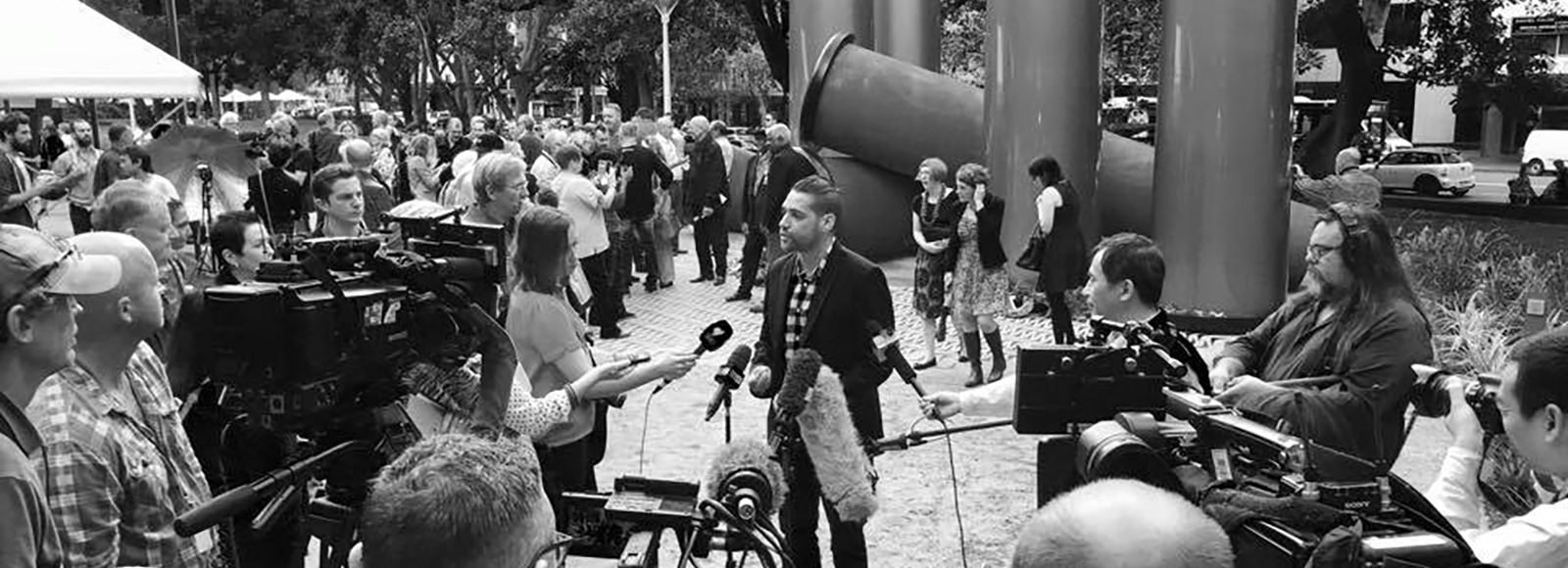
Artist residencies are an important way for educational institutions to be agents of knowledge exchange. UNSW Art & Design offers studio spaces, extensive facilities such as specialised tools and machinery, and expert staff who can provide new knowledge and insight – all of which are valuable resources for visiting artists.
Residencies are also an opportunity for established artists and designers to share their knowledge and skills. By working in an environment with students, residency recipients are in a unique position to act as ‘teachers’ and examples of how to find one’s way as a creative professional.
Aboriginal and Torres Strait Islander artists and designers have a particularly valuable contribution to make to creative arts faculties as part of universities. Engagements will Indigenous artists and designers offer opportunities to share and exchange insights into culture, race, racism, community, history, storytelling and the significance of creative expression with diverse non-Indigenous communities.
UNSW Art & Design recognises the exchange of information and skills between Indigenous artists and designers and communities of students and staff by way of Indigenous arts residencies open opportunities to enrich and build cultural connections.
As part of these dialogues, transmission and exchange UNSW Art & Design is pleased to announce the establishment of the Bowen Bungaree Aboriginal and Torres Strait Islander Arts Residency program, named in honour of Bowen Bungaree, the first documented Aboriginal artist from Sydney who sailed with John Oxley aboard the cutter HMS Mermaid in 1823.
This year, residencies were offered to eight Indigenous artists and designers, four of whom, Lucy Simpson, Tony Albert, Shevaun Wright, and Ethel-Anne Gundy, are already at the campus working in their nominated studio area or will be within the next month. The artists and designers selected for the inaugural residencies have well established and dynamic practices.
Lucy Simpson, a UNSW Art & Design graduate and a Yuwaalaraay woman belonging to the freshwater country of the Walgett and Angledool areas of North West NSW, is a successful Sydney-based textile artist. She is the recipient of the UNSW Art & Design Object Award in Design alongside the Longina Phillips Textiles Award and is the founder of Gaawaa Miyay, a contemporary Aboriginal design business. Lucy’s textile patterns often feature elements of the Australian landscape including leaf and bark patterns, birds, fish, and rock formations. She says that early morning walks around the Cook River in Marrickvile give her new inspiration and widen her imaginative thinking. Lucy will use her art residency to explore a new avenue of visual expression in the area of printmaking.
Tony Albert, born in Townsville, is a contemporary artist working in the areas of painting, photography, sculpture, and mixed media. He is the recipient of the Basil Sellers Art Prize (worth $100,000) and the Telstra National Aboriginal & Torres Strait Islander Art Award (worth $50,000). His public artwork, Yininmadyemi - Thou didst let fall, is a permanent feature at the Hyde Park War Memorial in commemoration of the contribution Indigenous soldiers have made within the Australian armed forces from the Boer War and WWI, to East Timor and Afghanistan. Tony’s work is largely known for text appropriated from popular film, music, and art history, together with photographs of his family in Lucha Libre, and an immense collection of “Aboriginalia” (a term the artist coined to describe kitschy objects and images that feature naive portrayals of Aboriginality). To further develop his Aboriginalia collection into a 2 dimensional form, Tony will work in the area of printmaking for his residency at UNSW Art & Design.
Practicing artist, lawyer, and UNSW Art & Design graduate, Shevaun Wright, will return to Australia this month to take up her art residency at UNSW Art & Design after completing an independent study program at the Whitney Museum in New York City. Shevaun is the 2015 winner of the Parliament of NSW Aboriginal Art Prize (worth $40,000). Her winning installation, Site Specific Work (Suggested Corporate Names — Catholic Child Abuse Compensation Entity), dealt with child sexual abuse and examined an array of legal, racial, and gender issues. Shevaun’s more recent arts practice explores the genre of ‘glitch art’ – the corruption of digital files and video codecs and the way in which this impacts on the formation of identity. Her resulting portraits are based on databent images rendered from television.
Ethel-Anne Gundy is an Australian actress, artist and UNSW Art & Design graduate. Alongside Anita Hegh, Miranda Tapsell, and Ursula Yoyich, Ethel-Anne plays an Indigenous woman in Kate Grenville’s extraordinary tragedy, The Secret River, which was staged at the Sydney Theatre Company and directed by Neil Armfield. She’s also played character roles in the ABC hits, Black Comedy and Redfern Now. As a practicing artist, Ethel Anne works in the areas of painting, sculpture, and installation, exploring the fallout of the forced removal of Aboriginal children from their families and their subsequent institutionalisation. These issues have personal resonance for Ethel-Anne as they are her own stories. As an art resident at UNSW Art & Design, Ethel-Anne plans to learn new skills and techniques to broaden her arts practice, particularly in the area of sculpture.
The Bowen Bungaree Aboriginal and Torres Strait Islander Arts Residencies are 12 months in duration and are designed to assist in the development of specific projects over this time.
